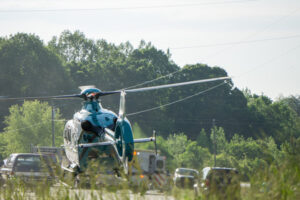Though firefighting is frequently associated with burning buildings, another cause for a firefighting squad to spring into action occurs in the wake of a flight tragedy, such as a plane or helicopter crash, resulting in a fire that threatens passengers, crew, and any area surrounding the crash site. Any delay could allow the fire to spread further beyond its epicenter, or, even worse, result in lives lost among the aircraft’s crew and passengers. When dealing with a rescue scenario, each passing second can mean the difference between life and death, so it is of the utmost importance that responding crews be fully prepared to respond in the most effective way possible.
Proper Training Tools
Muscle memory is a critical factor in neutralizing a hazard, and training simulations are the best way to ensure successful responses are instinctual. Training structure models and scenarios are provided in various forms, but the main differentiating factor between them is whether they are a fixed aircraft rescue and firefighting (ARFF) trainer, or a mobile one. In either case, both are designed to simulate the general configuration, interior structure, and consistency of the aircraft they are modeled after. And while both have their merits, there are specific advantages that can be obtained through utilizing either one for preparing for different scenarios. The key point is to provide a realistic simulation of differing circumstances to prepare a rescue team for all kinds of emergencies. There are still numerous aircraft crashes each year that result in a staggering number of deaths, and proper training can help prevent some of them.
A fixed ARFF simulator provides an environment in which a rescue team can experience and prepare for responding to a stable crash site. As the name suggests, a fixed aircraft simulator replicates situations in which a particular, regulation-standard aircraft has crashed and the situations that arises from its impact. Because of their precise nature, they can provide specialized training in specific situations that perfectly mirror real world scenarios. Furthermore, a fixed training simulation can use either flammable liquid hydrocarbons or propane to produce training flames, allowing them to simulate different types of fuel for crash-related fires. When specialized preparation is desired, they are the ideal training grounds for a rescue team. Since each aircraft is unique Fireblast Global offers fully customizable fixed aircraft simulators to accommodate each type of scenario to meet FAA Index A – E and ICAO Category 1 – 10 requirements.
Unlike a fixed simulator, a mobile ARFF simulator allows for utilization virtually anywhere. This all but guarantees that the trainees will be using the actual equipment, tools, and apparatus that they would use in a real-world response. Mobile simulators typically consist of a chassis based upon regulatory standards of a specific class of aircraft (helicopter, plane, etc.). Though not specific to any one model, mobile units generally replicate a mid-size commuter or department of defense (DoD) aircraft. While seemingly generic, mobile ARFF trainers have the advantage of customizable parts, so that one device can be used to simulate rescue scenarios for various types of crafts and situations. They offer a mutable experience, so that firefighting teams can learn the general techniques of various rescue scenarios. Unlike their fixed counterparts, mobile simulators generally use only propane as simulation fuel. For changeable rescues and firefighting scenarios, Fireblast offers mobile trainers with a myriad of customizable options.
Keeping Everything Kosher
Regardless of which is preferred, both types of simulators must meet strict regulatory guidelines. FAA (Federal Aviation Administration) and/or the ICAO (International Civil Aviation Organization) must be met depending on the region. To achieve this, simulator construction of either type, fixed or mobile, must adhere to published standards for this type of equipment. What this means for potential trainees is that all simulators closely mirror safety hazards and precautions that rescue teams should expect to deal with during a real emergency and that trainees can expect to receive their reoccurring certifications using the simulators. Since Fireblast strictly adheres to FAA and ICAO standards, our trainers are perfect for simulating practical scenarios that may be encountered in the field.
Contact Fireblast Global at 1-951-277-8319 for more information on our fire training services and how we can help you fight fires the smart way.

